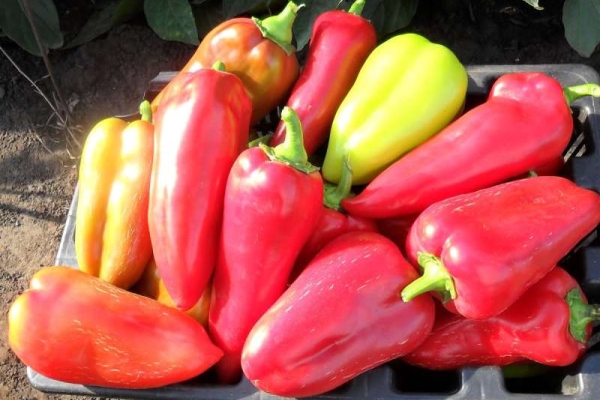 The industriousness of many Russian gardeners can only be envied. They manage to get excellent yields of peppers even in difficult climatic conditions of harsh Siberia and the Urals, collect delicious fruits of this heat-loving culture in the regions of the European North of the country.
The industriousness of many Russian gardeners can only be envied. They manage to get excellent yields of peppers even in difficult climatic conditions of harsh Siberia and the Urals, collect delicious fruits of this heat-loving culture in the regions of the European North of the country.
Of course, much depends on agricultural technology, as well as on the right variety.
Most often, summer residents of the areas of their temperate climatic zones give preference to determinant peppers - short, early, unpretentious. But tall peppers, which are characterized by higher productivity, long periods of fruiting, do not ignore. Yes, such plants are more comfortable in the south, but if you approach the agricultural technology of the crop wisely, plant early-ripening indices (and today there are some, not just late ones), the result will be impressive.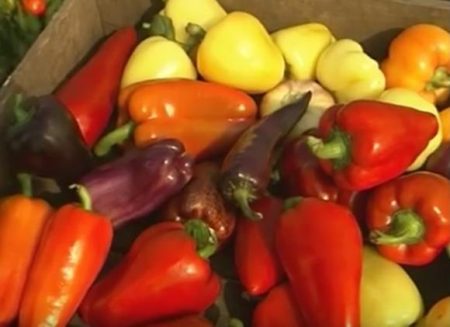
Content
Rules for growing tall peppers in greenhouses
To begin with, tall peppers are recommended to be cultivated in greenhouses. In shelters, it is easier for such plants to create optimal conditions, which means to guarantee a harvest.
Indeterminate varieties and hybrids are distinguished by high growth, stalk thickness, and dense foliage. Usually their leaf plates are large, saturated in green. Plants reach 150-200 cm in height, have many ovaries, which allows you to collect a large number of fruits from one bush. For the most part, varieties and hybrids of this type have mid-ripening and late ripening, although today many tall tall peppers are also bred.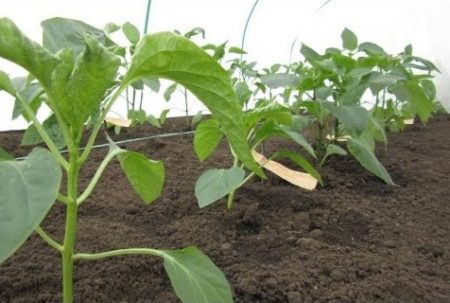
The cultivation of such varieties has its own characteristics, and this is due to the specifics of the plant.
- When choosing powerful tall peppers, do not forget about the height of the greenhouse. Bushes of more than a meter need shelters corresponding to them in size, otherwise they will not get the desired result.
- An important technique is the mandatory formation of such peppers, and this does not come down to a one-time pruning. The formation is carried out in stages, and if everything is done correctly, you will get the declared results according to the characteristics.
- Tall varieties and hybrids need to be well fed. Such plants are distinguished by their power, a large number of ovaries, therefore, the nutrient consumption of them is much higher than that of determinant varieties.
- It is required to strictly follow the recommendations on the planting scheme. Indets require freedom, and usually they are planted 3-4 plants per square meter.
- Before planting peppers, care must be taken to equip the supports. Trellis is a good option, you can also use individual stakes with a garter. Garter of such plants is required, while it is advisable to use not rope, but wide cotton stripes.
When the plant is formed, work begins already when the pepper grows to about 20 cm. As soon as its main stem "makes" a fork and the first bud appears in it, we need to start pinching. This bud, crown, as it is called, must be removed.
Pepper will branch further, forming side branches. Stepsons on them are removed, also pinch all the branches of the second order. In general, only the main skeletal shoot is always left, removing all the others.When pinching, they usually leave one ovary and a leaf above it, it will be he who is responsible for the nutrition of the future fetus.
Trellis is convenient in that all branches of tall pepper will be attached to transverse ropes or wire. This allows you to provide the necessary lighting for all branches, ovaries, to avoid shading. All shoots that are colorless, fattening, as well as weak twigs are to be removed. All yellow or wilted leaves are also removed.
When the pepper reaches a height of up to 100-120 cm, it is recommended to pinch the top, and about a month before the end of fruiting, you need to pinch all the branches of each order. This allows you to stop their growth and direct all the forces of plants to the fruits.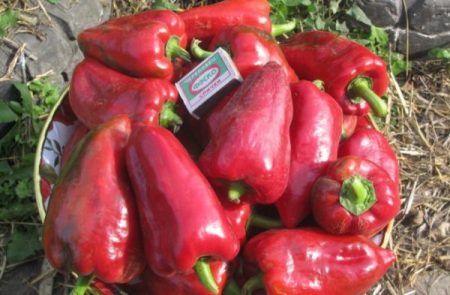
Varieties of Tall Peppers
Tall peppers are striking in the diversity of their fruits: in shape, size, and color. The review presents a variety of varieties and hybrids and this is only a small part of the amount that is presented to gardeners by breeders.
Merchant
A bush of pepper of this variety grows in a greenhouse almost under a meter. Medium-sized plant, despite a decent height, is compact. Fruits are drooping, have the form of regular cylinders. Peppers are dense, smooth and glossy. Ripened fruits are bright red, inside - up to 2-3 nests.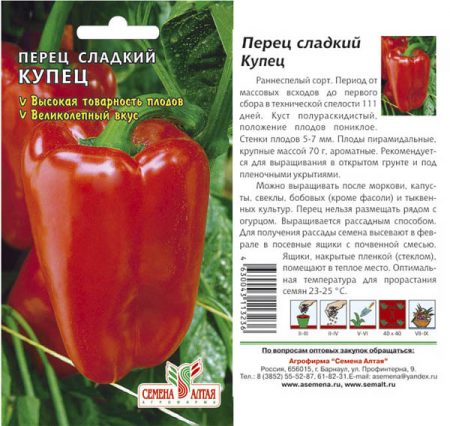
The pericarp in fruits reaches about 5 mm, in some peppers with good care large and thick-walled fruits form (wall thickness up to 8 mm).
The variety is mid-season, it takes up to 110-115 days to harvest the first fruits (state of technical maturity). The mass of peppers is up to 80-90 grams, the maximum is up to 130 grams. The taste is good.
Usually this pepper is used for preparation, preservation. A feature of the Kupets variety is the high commercial quality of peppers, yield (up to 3-4 kg in a greenhouse).
Atlant
Atlant pepper is also included in the State Register of the Russian Federation for varieties. Recommended for all regions, grows well under film shelters. Height - up to 110 cm, spreading branches. The plant requires garter, support and mandatory formation.
By the growing season - medium-early variety, after 105 days you can start harvesting green, in a state of technical ripeness of the fruit. These data are given taking into account the fact that pepper will receive all the necessary care and good nutrition.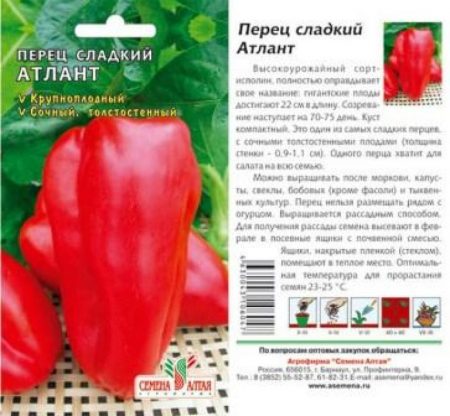
The fruits of Atlanta usually grow 130-150 grams, the shape is conical. Smooth glossy peel has a bright red color.
Wall thickness - up to 5 mm, fruit length - about 14 cm.
Taste is very high, pepper is recommended for fresh consumption, preservation.
Orange miracle
An interesting hybrid of pepper is Orange Miracle with bright sunny fruits. The plant reaches a height of almost 110 cm, so it requires garters to support. This hybrid has large leaves and the same large peppers.
The fruits are very fleshy, weighing up to 250 grams. The bush, hung with bright "cubes", looks very elegant. On average, up to 10 fruits are formed on one plant, so the yield of the Orange Miracle is really impressive. Peppers have a wall thickness of up to 7-10 mm, taste - excellent. A feature of the hybrid is the increased sweetness of the fruit, a fleshy and tender structure.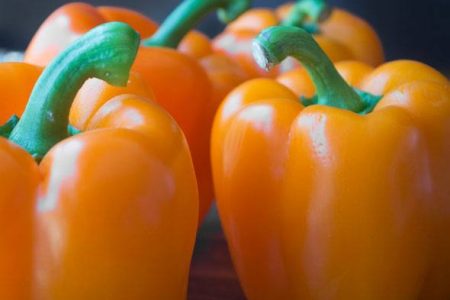
Harvested fruits for a long time do not lose marketable properties, suitable for transportation. In the northern regions, it is recommended to grow the Orange miracle only in greenhouses.
California Miracle
A wonderful variety that is believed to have been bred more than a century ago in the United States. Today, many gardeners know about this pepper and, despite the variety of new hybrids and varieties, they often prefer it to new products.
The first fruits of harvested pepper are removed after 110 days, but they are green, although they are suitable for food. For the fruits to reach biological maturity and bright red color, it will take another 21-25 days to wait.
The bush of this variety is powerful, grows up to one meter in height, but it all depends on the growing conditions. In greenhouses it will be higher, in open ground - slightly lower.Fruits - thick-walled peppers cubes, ribbed, with a glossy dense skin. The average fruit weight is 130 grams. The taste is excellent, and judging by the reviews of gardeners, this variety has pleased many. Peppers are used for stuffing, side dishes, baking, and are also suitable for all types of preservation.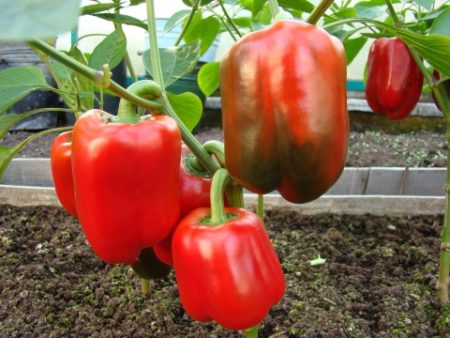
Since 1999, the California Miracle has been included in the State Register of the Russian Federation. It is appreciated for its unpretentiousness, stable productivity, endurance, resistance to many diseases. Even in an unfavorable season, this variety will thank you for the excellent harvest. Suitable for growing for those who are just starting to engage in the agricultural technology of sweet pepper.
Wonder tree
This hybrid attracts with its appearance, because it really resembles a small tree. Miracle tree is characterized by productivity, unpretentiousness.
Pepper grows well and bears fruit even in low light conditions, but it is still advisable to set aside good sunny places for it. The height of the plant is up to 170-200 cm, and this, of course, is impressive. A lot of medium-sized ones are formed on the bush, weighing about 50 grams of fruit. Peppers of the Wonder Tree look like small prisms, have a dense skin and a bright red color.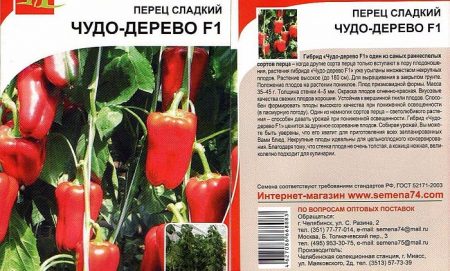
The pulp is juicy, the taste is good. Fruits are suitable for cooking, are used for preservation.
Cockatoo
Usually, about 115 days pass before harvesting the first fruits on a hybrid of Kakadu pepper, but the period may be less. This hybrid gives the best results when grown in a greenhouse, while taking into account that its height reaches almost one and a half meters.
The bush is very tall, powerful, highly leafy. The branches are sprawling, but thanks to the stocky stalk, the plant is very stable. During fruiting, a garter is recommended.
Pepper fruits are narrow, slightly bending cylinders, similar to the beak of a large parrot, hence the name of the hybrid. Their length is up to 30 cm. In technical ripeness, peppers are dark green in color, when fully ripened, they turn red.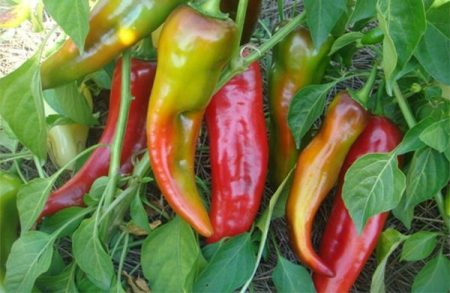
The fruit mass is about 350-500 grams, up to 8-10 large peppers ripen on the bush. Hybrid Kakadu F1 is demanding on heat, light, so in the northern regions they grow it only in greenhouses. The use of fruits is universal.
Hercules
Early Hercules in three months will present you with large juicy fruits. Peppers of this variety are very juicy and sweet, it is no coincidence that gardeners in many regions highly appreciate the taste qualities of Hercules.
It is recommended to grow this pepper in greenhouses, and only in the southern regions is landing in open ground suitable.
Variety bushes grow up to 80-100 cm, middle leafy.
Cube-shaped peppers have a bright red color, the walls are thick, up to 7-8 mm. The peel is highly glossy, the fruits are drooping, inside there are up to 3-4 nests. The taste of ripe peppers is very good.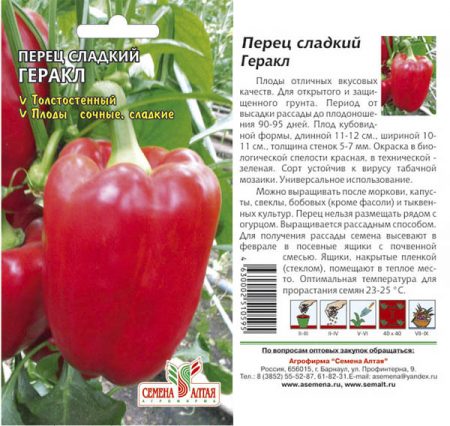
The variety is resistant to fusarium and other diseases. Harvest, unpretentious, and therefore noteworthy variety!
Chord
Very good performance in protected ground shows pepper Accord. From one square meter, you can remove up to 7 kg of fruit - tasty, juicy, suitable for transportation. According to the ripening dates, the Accord is medium early pepper (up to 110 days).
The variety is tall, the leaves are medium sized, wrinkled. The fruits resemble cones, reaching 190-200 grams in weight. Peppers are drooping, with a smooth and shiny skin, aligned. The color at full maturity is red, in a state of technical ripeness - light green.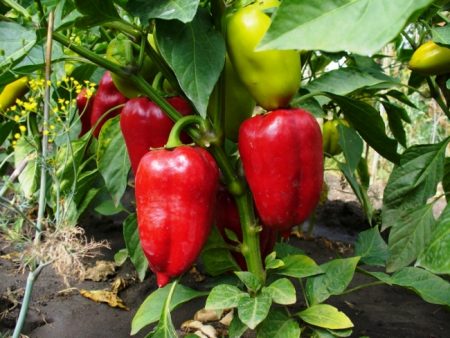
This variety is appreciated for the excellent taste of peppers, for keeping quality. The fruits can be used to prepare various dishes, they are good in salads, in preservation.
Claudio
“Dutchman” Claudio F1 is best grown in a greenhouse, as the yield on the ridges is very dependent on weather conditions.
It is positioned as an early hybrid, but this applies only to the fruits of technical ripeness - up to 90 days. It takes much longer for the peppers to mature and turn red - up to 140 days.
The bush is powerful, tall, with an approximate height of 90-100 cm. Fruits are large elongated "cubes", reaching a weight of up to 180-200 grams. Peppers, when fully ripened, have a beautiful dark red color.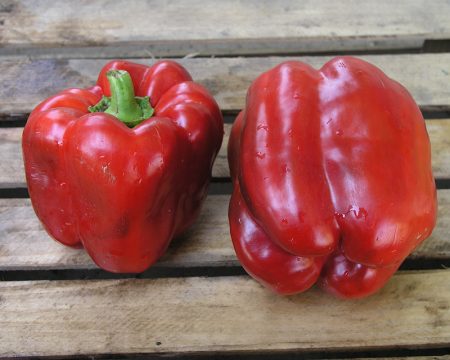
They are distinguished by thick walls - up to 10 mm, excellent taste. The pulp is very juicy, aromatic. On one bush, up to 10-12 fruits can form, but only with full care. The hybrid is resistant to temperature changes, does not reduce productivity even in stressful situations.
Claudio peppers are very dense, aligned, suitable for storage, transportation. The hybrid is valuable precisely because of the high commercial quality of the fruit.
Latino
This hybrid has gained fame among gardeners due to its productivity. From one square meter, you can remove up to 12 kg of fruit, but only with good and proper care.
Latino Hybrid - early ripening, up to 110 days in maturity. It is better to grow it in a greenhouse, using trellises for garter. It gives excellent results when forming in two stems. The height of the bush is up to 100-110 cm, but the bush itself is quite compact. The fruits are cuboid in shape, very juicy, weighing up to 180-200 grams. The length of the “cubes” is up to 15 cm, the color is bright red, saturated.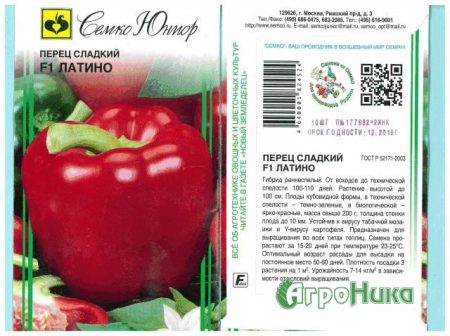
During fruiting and ripening Latino bush looks very colorful. The fruits are distinguished by excellent taste, are used in all types of preservation, in home cooking. The peculiarity of Latino F1 is its resistance to disease, stress, adverse conditions.
Cornet
Fans of unusual peppers can recommend a productive and very tasty variety of Cornet. His bush is very tall, reaches a height of 150-160 cm, highly leafy. Fruits are drooping “prisms”, large, up to 190-230 grams. The pulp is very juicy, pericarp - up to 6 mm. The original color of the peppers is attractive - dark brown, which gives the whole plant some magical beauty. To taste Cornet - sweet, has a pleasant aroma.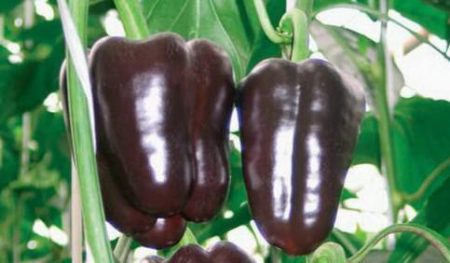
Garter, support, mandatory formation is required. But in the conditions of film greenhouses, its branching is limited, so the maintenance is simple. The value of the variety is unpretentiousness, prolonged bearing, high carotene content in fruits.
The variety is also very good in yield, on average up to 5-5.3 kg of fruits can be harvested from one square meter.
The first fruits are removed after about 105 days.
Tall pepper dressing
The review presents a variety of varieties and hybrids, the yield of almost all is quite high. But we must remember that powerful tall peppers require appropriate nutrition. Therefore, choosing them for growing, do not forget about the timely feeding.
The usual feeding schedule for such "giants" is about once every two weeks, but the condition of the plants themselves must be taken into account. It is advisable to alternate organic and mineral fertilizers, it is very convenient to use ready-made mixtures, which are in variety offered in specialized stores.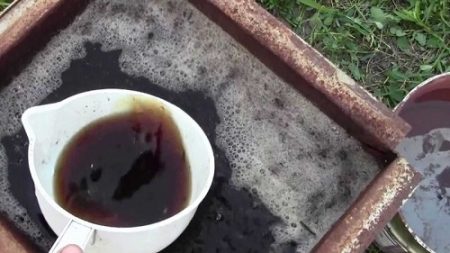
In the seedling period, peppers are fed twice. If you are planning a dive, then both top dressing is carried out after a transplant, after about 10-14 days. What to use:
- humates (bred and watered according to instructions);
- urea
Well suited for micronutrient seedlings, such as Ideal, Aquadon.
It is very important to properly prepare the soil for planting peppers, while fresh manure is strictly prohibited. In the fall, rotted mullein is brought in, in the spring - superphosphate, ash.
The first top dressing after transplantation is carried out in about 14-15 days, organics are used.Mullein must be insisted in advance so that it can stand for a week in the water, and then infuse every bush with infusion.
The next top dressing, according to the schedule, no earlier than in 10-14 days. Here mineral compounds are suitable (if organic feeding was the first) or vice versa. Nitrogen fertilizers are needed for the growth of peppers, but at the time of flowering and fruiting, they need phosphorus and potassium.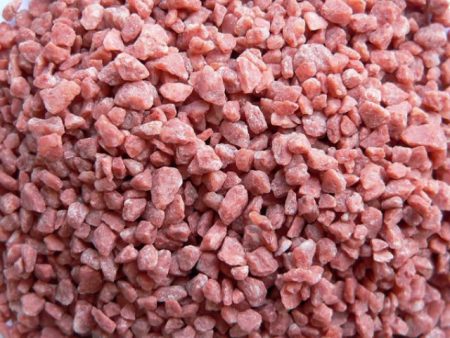
Peppers are especially demanding for potassium; when it is deficient, the leaf plates become coarse, and the fruits are small and have a mediocre taste. Therefore, it is necessary to provide the plants with a sufficient amount of this component, but do not forget about the norms.
For top dressing, you can use various folk remedies, among which - baker's yeast, iodine compounds, boric acid and, of course, wood ash.
Proper care of tall handsome peppers will allow you to get a high harvest and delight your family with ripe and tasty vitamin fruits.
Reviews
Renata, Yaroslavl
I tried to grow different tall peppers. By description I liked Kakadu, but in practice I was not pleased. The fruits began to go late, thin-walled, some uneven. I note, perhaps, only one advantage - large size. All went to me for processing. Seeds were taken from Zedek; out of seven, only three got out.
Tatyana, Nizhny Novgorod
I always have so many peppers, among them the most beloved are Indalo and Latino. Harvest, tasty and always on the bush a lot. I define them only in a greenhouse, I have a special one for peppers. Grow fast, early. In our area, such peppers are a real find for gardeners. But they require care, they love to be fed well. They also need good soil, otherwise the fruits will be small and small.

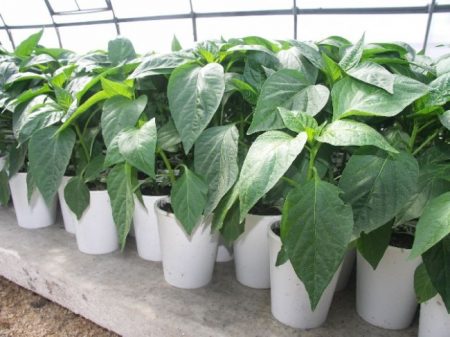



 Calorie pepper stuffed with meat and rice - BZHU per 100 grams
Calorie pepper stuffed with meat and rice - BZHU per 100 grams Gorky pepper - the best varieties for open ground
Gorky pepper - the best varieties for open ground Hot pepper seeds - the best varieties for open ground and reviews
Hot pepper seeds - the best varieties for open ground and reviews Capsicum tincture for hair - how to use and reviews
Capsicum tincture for hair - how to use and reviews